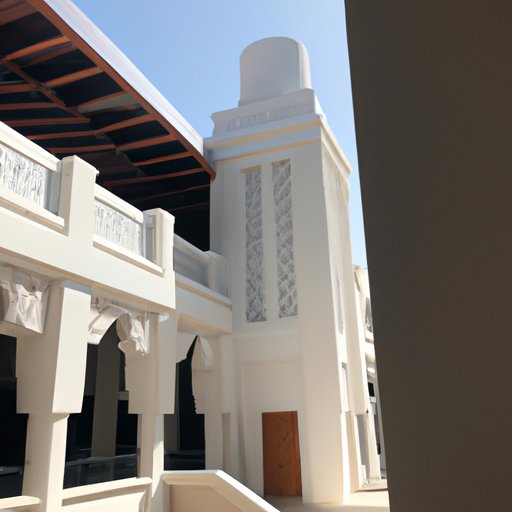Introduction
Architecture is a form of art that involves designing and constructing buildings and other structures. It encompasses a wide range of styles and techniques, which have evolved over time in response to the needs and desires of society. Understanding the various types of architecture is essential for appreciating the built environment and the impact it has on our lives.

Overview of Different Types of Architecture
Architectural styles can be broadly divided into three main categories: traditional, modern, and postmodern. Traditional styles are rooted in history and include ancient, medieval, Renaissance, Baroque, Rococo, Neoclassical, Gothic Revival, Art Nouveau, and Art Deco styles. Modern styles emerged in the 20th century and include the International Style, Postmodernism, and other contemporary styles. Postmodern styles are a reaction to Modernism, blending elements of both traditional and modern styles.

Exploring Architectural Styles Through History
Ancient architectural styles date back thousands of years and are characterized by simple forms, geometric shapes, and basic materials such as mud bricks, stone, and wood. Examples of these styles include Ancient Greek, Roman, and Egyptian temples and monuments. Medieval architectural styles developed during the Middle Ages (5th-15th centuries) and are characterized by heavy use of stone, pointed arches, ribbed vaults, and elaborate ornamentation. Notable examples of this style include the cathedrals of Europe.
Renaissance architecture (14th-17th centuries) was inspired by the rediscovery of classical ideals and focused on harmony, proportion, and symmetry. Notable examples include the Palladian villas of Italy and the Chateaux of France. Baroque and Rococo styles (17th-18th centuries) were characterized by grandiose forms, extravagant decoration, and theatrical effects. Notable examples of these styles include the Palace of Versailles and the churches of Rome.
Neoclassical and Gothic Revival styles (18th-19th centuries) were both inspired by classical ideals but took different approaches. Neoclassical architecture emphasized order, balance, and simplicity while Gothic Revival architecture focused on verticality, pointed arches, and intricate ornamentation. Notable examples of these styles include Thomas Jefferson’s Monticello and London’s Houses of Parliament.
Art Nouveau and Art Deco styles (late 19th-early 20th centuries) were both characterized by ornamentation and a focus on modern materials such as steel and glass. Notable examples include the Eiffel Tower and the Chrysler Building. The International Style (mid-20th century) was a modernist movement focused on functional forms, minimal ornamentation, and the use of industrial materials. Notable examples include the Seagram Building and the Guggenheim Museum.
Postmodernism (late 20th century) was a reaction to the International Style, blending elements of traditional and modern styles. Notable examples include the Pompidou Center in Paris and the Getty Center in Los Angeles.
Understanding the Principles Behind Different Types of Architecture
In addition to understanding the various architectural styles, it is important to understand the underlying principles that guide the design of buildings and other structures. These principles include form and function, proportion, balance, symmetry, harmony, scale, and unity. Form refers to the overall shape and structure of a building, while function refers to its purpose and how it is used. Proportion is the relationship between different parts of a building or structure. Balance refers to the distribution of visual weight within a structure. Symmetry is the repetition of elements on either side of an axis. Harmony is the combination of elements in a way that creates a unified whole. Scale refers to the size of a building relative to its surroundings. Unity is the sense of wholeness created by all of the elements working together.
Examining the Impact of Regional Differences on Architecture
Regional differences can also have a significant impact on the design of buildings and other structures. Climate, geography, local resources, and social and cultural influences all play a role in shaping the built environment. For example, climate can affect the type of materials used in construction and the orientation of a building to take advantage of natural ventilation. Geography can determine the availability of certain materials, such as wood or stone, and influence the layout of a city or town. Local resources can dictate the type of building materials available and their cost. Social and cultural influences can influence the aesthetics of a building, such as its color, decoration, and symbolism.

Analyzing the Role of Technology in Shaping Modern Architectural Styles
Technology has had a major impact on the development of modern architectural styles. Advances in building materials, structural systems, and energy efficiency have enabled architects to create more complex and efficient structures. Steel and reinforced concrete have enabled the construction of taller and more flexible buildings, while advances in insulation and glazing technologies have made modern buildings more energy efficient. Structural engineering has enabled the creation of innovative forms, such as the hyperbolic paraboloid roof of the Sydney Opera House.
Investigating the Interplay Between Architecture and Culture
The interplay between architecture and culture is also an important factor in understanding different types of architecture. Historical context, symbolic meaning, and aesthetic values all contribute to the design of a building or structure. Buildings often serve as symbols of power, wealth, or status, and their design can be used to convey a particular message or sentiment. Aesthetic values, such as beauty and harmony, can also be expressed through architecture. Understanding the historical and cultural context of a building can help us appreciate its design and meaning.
Conclusion
Architecture is an ever-evolving art form that reflects the needs and desires of society. By exploring the different types of architecture, from traditional to modern styles, we can gain insight into the principles behind their design, the impact of regional differences, and the role of technology in shaping modern architectural styles. Moreover, we can gain a deeper appreciation for the interplay between architecture and culture, and the historical and symbolic meaning of buildings and other structures.
(Note: Is this article not meeting your expectations? Do you have knowledge or insights to share? Unlock new opportunities and expand your reach by joining our authors team. Click Registration to join us and share your expertise with our readers.)
